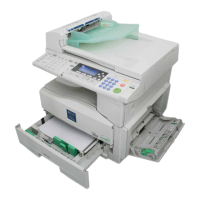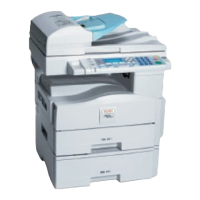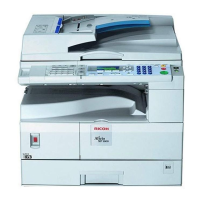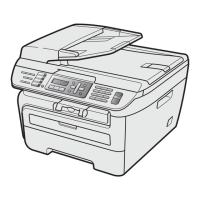BIT SWITCHES 9 March 2004
3-28
G3-1 Switch 03 SP No. 1-105-004
No FUNCTION COMMENTS
0 DIS detection number
(Echo countermeasure)
0: 1
1: 2
0:
The machine will hang up if it receives the same
DIS frame twice.
1: Before sending DCS, the machine will wait for the
second DIS which is caused by echo on the line.
1
Not used Do not change the setting.
2 V.8 protocol
0:
Disabled
1: Enabled
0:
V.8/V.34 communications will not be possible.
Note:
Do not set to 0 unless the line condition is always
bad enough to slow down the data rate to 14.4 kbps
or lower.
3
ECM frame size
0: 256 bytes
1: 64 bytes
Keep this bit at “0” in most cases.
4 CTC transmission conditions
0: After one PPR signal
received
1: After four PPR signals
received (ITU-T standard)
0:
When using ECM in non-standard (NSF/NSS)
mode, the machine sends a CTC to drop back the
modem rate after receiving a PPR, if the following
condition is met in communications at 14.4, 12.0,
9.6, and 7.2 kbps.
NTransmit N send≤ Re
N
Transmit- Number of transmitted frames
N
Resend- Number of frames to be retransmitted
1: When using ECM, the machine sends a CTC to
drop back the modem rate after receiving four
PPRs.
PPR, CTC: These are ECM protocol signals.
This bit is not effective in V.34 communications.
5
Modem rate used for the next
page after receiving a negative
code (RTN or PIN)
0: No change 1: Fallback
1: The machine’s tx modem rate will fall back before
sending the next page if a negative code is
received. This bit is ignored if ECM is being used.
6
Not used Do not change the setting.
7
Polarity detection switch
1: On (Default for Japan model)
0: Off (Default for other models)
The facsimile may incorrectly detect the polarity in
some environments. In such environments, the
facsimile mistakenly closes an established
communication. To prevent this problem, you can
turn off the polarity detection switch. When this
switch is off, the Communicating LED or an
accounting-management program takes tame to
turn on.
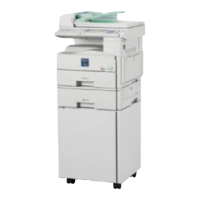
